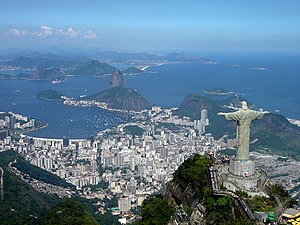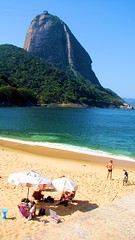| Panoramic Cristo Redentor, Bahia de Guanabara, Pão de Açúcar e Botafogo, Rio de Janeiro, Brazil |
Getting to know Brazil which is an enormously popular attraction among the international tourists is a must before you travel. Try to know a few interesting facts about Brazilian destinations that possess something unique and wonderful making them worthy of worldwide recognition. Before you get into the many attractions, interesting activities, fantastic beaches, uncommon wildlife, exotic places and many more, here are some interesting facts about Brazil:
Brazil is the biggest country in Latin America and one of the biggest in the world geographically. With a coastline of over 7,367 kilometers, Brazil's size is even larger than Italy, Portugal, Japan, Spain, Indonesia and South Africa combined.
In terms of religion, it is the biggest Catholic country and second highest Christian population which presents the tallest iconic statue of Christ the Redeemer overlooking Rio de Janeiro which is considered on of the seven wonders of the world.
Brazil is the only country to have won 5 World Cup titles and is one of the main exporters of soccer players and coaches around the globe. Soccer or football (futebol, as it is called here) is a national passion played on the streets, fields, beaches, indoors, outdoors and of course. Maracanã is one of the world's biggest and most beautiful stadiums. World Cup 2014 and World Olympics 2016 will be in Brazil.
The world's largest rainforest which comprises 2.3 square million miles is found in the Amazon region in Brazil where the famous Amazon River is found. It is home to wonderful ecological displays enriched by diverse flora and fauna and unique animal species. Well, it also holds a record of deforestation and illegal logging and hunting.
The most extravagant and tourist drawing carnival is scattered around Brazilian cities mainly Rio de Janeiro, São Paulo, Recife and Olinda. It is an awaited moment of the year which requires long-term preparation in terms of choreography, music and production originality. With the lively samba rhythm, tourists both local and foreign can dance to their hearts' desire. While Carnival in big cities is commercialized, the one at the countryside is free for public participation and appreciation.
Brazil is one of the biggest agricultural and industrial exporters. Coffee, soybeans, wheat, rice, corn, sugarcane, cocoa, citrus textiles, shoes, chemicals, cement, lumber, iron ore, tin, steel, aircraft, motor vehicles and parts, other machinery and equipment. That is why, it is also among the top ten growing economies in the world together with China and India. Brazil is a Third World country with a First World economic performance.
Brazil is one of the most preferred travel destinations in Latin America due to its diverse attractions. If you want to know more about this wonderful country, visit http://braziltravel-ram.blogspot.com/ and learn more about Brazil.
See Ezine Source here
See Ezine Source here













